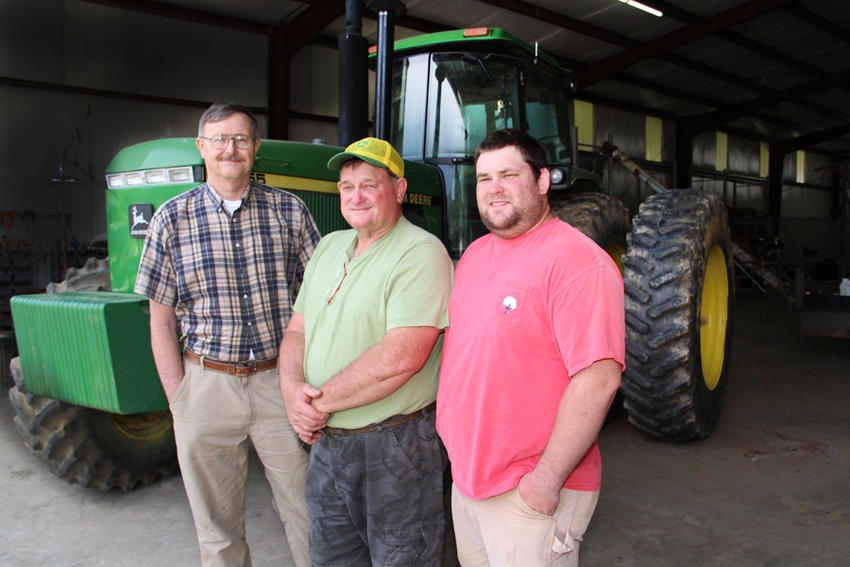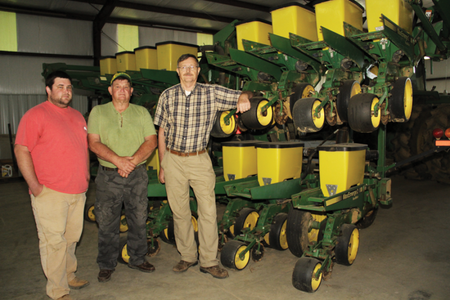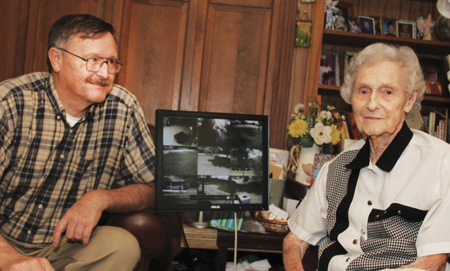
Proclaiming themselves "just country farmers," Colin Collins and his brother David, along with Colin’s son Clay, run a 1,500 acre soybean operation, plus timber land, in Union County, Miss., and in the best Jeffersonian tradition, lead lives of myriad interests, community service, neighborliness, independence, and self-sufficiency.

As would be expected of sons of an Ole Miss lawyer, legislator, postmaster, history buff, and farmer, Colin Collins and David Collins dutifully attended their father’s alma mater — Colin earning a degree in education, and David a degree in chemistry.
But they became neither educator nor scientist.
Instead, both answered the call of the land, returning to the Union County, Miss., farm that has been in their family for generations, harking back to their ancestor, William Bridges, who came here from Kentucky in a covered wagon in the 1830s when the area first opened for settlement, and began farming the bottom lands adjacent to the Tallahatchie River.
“I’d grown up in farming,” says Colin, the elder brother. “Our father, William Collins, had me on a tractor when I was eight or nine years old. So, when it came time to choose a livelihood, I chose farming over teaching. This is all I wanted to do.”
David actually had a go at putting his chemistry degree to use in the corporate world, taking a job with Dow Chemical at Baton Rouge. “It wasn’t for me,” he says. “It didn’t take me long to come home. From an economic standpoint, it probably wasn’t the wisest decision I ever made [he smiles], but I’ve never regretted it.”
WHAT’S ON TAP: Important upcoming events: Delta Farm Press Calendar of Events
Today, along with Colin’s son Clay (Ole Miss also, business management degree), they have a 1,500 acre soybean operation and timber land, and in the best Jeffersonian tradition, lead lives of myriad interests, community service, neighborliness, independence, and self-sufficiency.
“We’re just country farmers,” David modestly avers as he settles his 6 foot 6 frame into a chair in their shop on a late April morning after tornadoes have raked the state and rains have idled their planting start by perhaps another week [planting actually began May 5]. “I can’t imagine there’s anything about us that would be of interest to anyone.”
Colin smiles, nods in agreement.
Built a 15-row planter
And then, bit by bit, the details emerge: Their if-we-can-make-something-ourselves-and-save-some-money credo — example, combining two 8-row planters with 38-inch spacing to make a 15-row soybeans planter with 19-inch spacing and adding a caddy.
“It cost $20,000,” says Colin. “A new one would’ve been $100,000 and we’d have needed a bigger tractor to run the hydraulics. We got the idea from [Pontotoc, Miss. farmer] Tommy Harrison. It allows us to pull a much heavier planter with a smaller tractor, and save a lot of money in the process."
AG NEWS delivered daily to your inbox: Subscribe to Delta Farm Press Daily

A GO-KART ENGINE was added to a grain auger in one of the Collins brothers’ equipment adaptations.
And, he says of another of their equipment adaptations, "We've probably got the only direct-drive seed tender auger in existence.”
David interjects: “The auger was originally driven by a hydraulic motor, but when that motor failed, we tried to come up with a drive that wouldn’t require hydraulic power. So we mounted an old gas motor onto the auger itself and used sprockets to reduce rotation speed to a right-angle gearbox at the base of the auger.
“To remotely turn the auger off and on, I first tried an electric clutch that I took off of an old riding lawn mower, but that idea failed — too much mass to get it started spinning when I flipped the toggle switch. So I had to go back to the drawing board.
“I got a cheap go-kart motor that has a centrifugal wet clutch and hooked its throttle up to a 12 volt linear actuator that is controlled by a wireless remote control. Whenever I want to stop the auger from turning, I idle the engine by just pressing a button on the wireless remote control. To resume auguring, pressing the other button advances the throttle, which revs up the engine and engages the wet clutch. It works great, is very reliable, never chokes down, and no hydraulics required.”
They do it themselves
If it can be made, they make it; if it needs fixing, they do it — outsourcing only equipment engine overhauls. “Our newest tractor is a 1992 model,” Colin says. “Our combines are ’85 and ’96 models. They’re good machines, we maintain them properly, they do the job for us, so why buy new ones?”
Colin put his welding skills to use to build a 200-gallon fuel tank for their service truck. “It was a challenge to make a tank that big that doesn’t leak. But I managed it.”

TWO CORN PLANTERS were combined, using a caddy arrangement, to make a 15-row soybean planter. This allows pulling a heavier, wider planter with a smaller tractor. From left are Clay, Colin, and David Collins.
He has been “teaching myself to weld aluminum” — a different technique from regular welding. “I made aluminum doors for our Polaris side-by-side ATV. It was a lot cheaper than buying them.”
A voracious reader on wide-ranging topics, particularly those of the natural world, he also is a dedicated gardener, keeping the family freezers stocked with veggies, including the purple hull peas that, with corn bread, “are mighty fine eating.”
June, his wife of 41 years, babysits their grandson, Graham, and granddaughter, Jovie, on weekdays while their daughter, Anna Claire, teaches at nearby West Union school. She laughs that her husband, Shane Hall, “married me just so he would have a good place to hunt – he once bagged two turkeys with one shot on the farm’s 40 acres of bottomland woods.”
He has been president of the Union County Farm Bureau organization since 1981, and is actively involved in its issues. “I keep thinking they’ll talk someone else into taking the job,” Colin says, “but so far, they haven’t.” One of his current goals is getting support for state regulations controlling non-native animals that pose a threat to agricultural operations. He also serves on the Producer Advisory Council for the Northeast Mississippi Extension and Research Center.
David’s interests include civics and current events.
“Some of my opinions aren’t popular,” he acknowledges. “For example, in recent years I’ve come to believe that it’s a good idea to require people to have health insurance. Yet, I never got health insurance for myself, because my health has always been excellent.
“Even though I never expected to get sick, the new Affordable Care Act forced me to buy health insurance. Then, a month ago, I began having symptoms that resulted in a heart catheterization and stent. Having that insurance saved me $40,000.”
Multi-camera security system
Electronics is another of David’s hobbies. He built a computer system for the Union County Heritage Museum at nearby New Albany, serves on its board of directors, and is currently involved in a drive to raise more than $1 million for the museum expansion project.

DAVID COLLINS installed a 12-camera security system that allows his 97-year old mother, Vernis, to see what's going on at the farm shop, at her house, and at her sons' houses.
Another project was installing a security camera system for the farm. Twelve cameras allow their 97-year old mother, Vernis, to monitor goings-on at the farm shop, at her sons’ houses, and the surroundings of her house.
The cameras are motion activated, and the monitor displays only the scenes where action is occurring. As a security measure, the system records and stores output from any camera that detects motion.
“It’s really a simple system,” David says. “It only cost a few hundred dollars and it keeps Mother involved in what we’re doing.”
Colin notes that, "We also have radios for staying in touch and for up-to-the-minute weather forecasts, and of course, iPhones, which help us to track weather for making spraying decisions.
While last year turned out to be a bumper year for most Mississippi row crops, David says their soybean yields were off a bit due to a mid-August dry spell. None of their land is irrigated.
“We averaged about 33 bushels, but prices were good, so we came out OK,” he says. “Many farmers are in much better shape as a result of good yields and prices in recent years. It has been a big relief for us to be in a position to not have to borrow money to make a crop.
“But,” he says wryly, “August is not my favorite month.”
In addition to the family land, Colin says, “We rent land all up and down Highway 30, going 10 miles toward Oxford and 4 miles toward New Albany. It’s mostly all creek bottom and Tallahatchie River bottom land, and about a third of it is subject to overflow. There are some fields where there are floodwater marks on trees as high as 8 feet.”
Of the land they farm, about two-thirds is owned, the rest rented. They just recently concluded the purchase of a 150-ace farm they’d been renting for 20 years. The sale, David says, “was based in large part on respect between our family and theirs over many years, and their knowing that we will be good stewards of the land."
With the rain and cold that were pushing this year’s planting into May, he says, “We like to start planting as early as we can, preferably the last week in April if we can get in the fields. But we’re not worried … yet.”
Multiple varieties spread risk
They grow mostly Group IV and Group V Asgrow beans, Colin says, selecting several different varieties to spread risk. “We used to plant a lot of early Group IVs, but we had a lot of shattering, and they didn’t hold up as long in the field if we had weather delays at harvest. Our dealer is Morris Farm Supply — they’re good folks to work with.
“We’ve been in continuous soybeans for 14 years now, and we’re overdue to start some rotation with corn. But right now we don’t have a corn planter, since we used it to build the 15-row soybean planter.”
They used to grow some milo from time to time as a rotation crop, Colin says, “But weather sometimes keeps us from getting it planted, and elevators don’t like to take milo when they’ve got soybeans coming in hot and heavy.”
They have 48,000 bushels of bin storage and will hold a portion of the crop to sell in the spring when prices are usually better than at harvest.
“That system has worked well for us,” David says. Their beans are sold through ADM and Cargill at Memphis. “We hire our trucking — we don’t have any 18-wheel rigs, but do have a hopper bottom grain trailer.”
They still do conventional tillage with a disk and do-all, he says. “We tried no-till a few years, but it just didn’t do well for us. On some fields, we were able to increase yields, but on others we had trouble getting a stand, and eventually got a hardpan buildup.
“After burndown with Roundup and 2,4-D, we’ll disk twice, run the do-all, and plant on 20-inch rows. After emergence of the crop and the first flush of weeds, morningglories force us to tank mix Resource with Roundup. We spend more money on Resource than Roundup.
“Two sprayings that include Resource give us perfect control,” David says, “but morningglories are a perpetual problem because river overflows always bring in new seed.
“Wild garlic has been giving us fits during harvest. So this year, we’re adding 2,4-D at burndown to suppress it. The only other Roundup resistance we’ve had so far is with marestail in a few fields. We’re on the verge of needing to apply pre-emerge to control it.”
Wild hogs, deer a problem
As is increasingly the case in many areas of the state, wild hogs and deer are a problem, Colin says. “We lost 20-25 acres last year to hogs, and we had to replant 15-20 acres twice due to deer damage.
“Over a period of 8 months, we trapped 239 wild hogs, but they’re still gaining on us. Last year, was the worst damage we’ve ever had. And they’re getting smarter — it’s much harder to trap them than it once was. Some area farmers have had to stop growing corn because of the hogs. Fire ants and coyotes are also a problem.”
To that end, Colin is working within the Farm Bureau to try and get support for legislation that would curtail ownership or transporting of non-native species that could become invasive.
Their farm machinery lineup, all John Deere, includes two 4955 tractors, a 4760, 4840, 4640, and 4230; Deere 9600 and 7720 combines, and an Agco Spra-Coupe.
“We don’t have auto-steer on our sprayer,” David says, “but we do have GPS and automatic boom section control. Eliminating overspray saves a lot of money. I used to turn the five boom sections on and off manually, but it nearly drove me nuts. Then I got the GPS boom section control system and that eliminated a big headache. It’s a necessity in my book.”
They did add one new equipment item this year, a spreader truck. David says “You can get small 12 volt cameras and monitors for practically nothing online, now-a-days, so I got two for the new spreader truck — one so we can see how much material there is in the hopper and another mounted at the rear so we can see the drag chain and spinners moving.”
“Lime really pays off for us,” Colin says. “It has made a big difference — on some fields, we’ve seen a doubling of yield.”
Although their collegiate loyalty is to Ole Miss, both Colin and David readily acknowledge their appreciation for the help and advice from Mississippi State University specialists and researchers. “We’ve got a lot of friends in Extension, and they’ve been a real asset to us over the years,” Colin says.
About the Author(s)
You May Also Like



